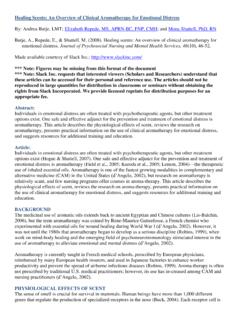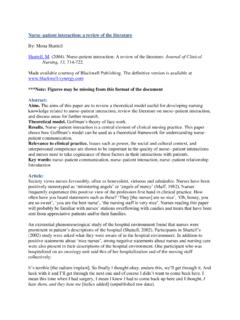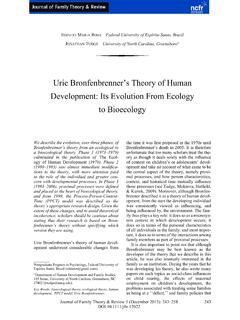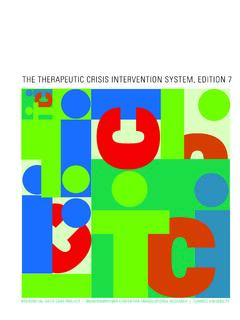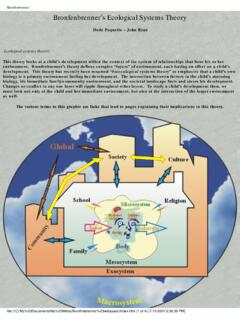Transcription of Urie Bronfenbrenner's Theory of Human Development: Its ...
1 Urie Bronfenbrenner's Theory of Human Development: Its Evolution From Ecology to Bioecology By: Edinete Maria Rosa and Jonathan Tudge This is the peer reviewed version of the following article: Rosa, E. M., & Tudge, J. R. H. (2013). Urie bronfenbrenner s Theory of Human development: Its evolution from ecology to bioecology. Journal of Family Theory and Review, 5(6), 243 258. which has been published in final form at This article may be used for non-commercial purposes in accordance with Wiley Terms and Conditions for Use of Self-Archived Versions. ** 2013 National Council on Family Relations. Reprinted with permission. No further reproduction is authorized without written permission from Wiley. This version of the document is not the version of record. ** Abstract: We describe the evolution, over three phases, of Bronfenbrenner's Theory from an ecological to a bioecological Theory .
2 Phase 1 (1973 1979) culminated in the publication of The Ecology of Human Development (1979). Phase 2 (1980 1993) saw almost immediate modifications to the Theory , with more attention paid to the role of the individual and greater concern with developmental processes. In Phase 3 (1993 2006), proximal processes were defined and placed at the heart of bioecological Theory , and from 1998, the Process Person Context Time (PPCT) model was described as the Theory 's appropriate research design. Given the extent of these changes, and to avoid theoretical incoherence, scholars should be cautious about stating that their research is based on Bronfenbrenner's Theory without specifying which version they are using. Keywords: bioecological Theory | ecological Theory | Human development | PPCT model | Urie bronfenbrenner Article: Urie Bronfenbrenner's Theory of Human development underwent considerable changes from the time it was first proposed in the 1970s until Bronfenbrenner's death in 2005.
3 It is therefore unfortunate that too many scholars treat the Theory as though it deals solely with the influence of context on children's or adolescents' development and take no account of what came to be the central aspect of the Theory , namely proximal processes, and how person characteristics, context, and historical time mutually influence those processes (see Tudge, Mokrova, Hatfield, & Karnik, 2009). Moreover, although bronfenbrenner described it as a Theory of Human development, from the start the developing individual was consistently viewed as influencing, and being influenced by, the environment. The family thus plays a key role: it does so as a microsystem context in which development occurs; it does so in terms of the personal characteristics of all individuals in the family; and most important, it does so in terms of the interactions among family members as part of proximal processes.
4 It is also important to point out that although bronfenbrenner may be best known as the developer of the Theory that we describe in this article, he was also intensely interested in the family as an institution. During the years that he was developing his Theory , he also wrote many papers on such topics as social class influences on child rearing, the effects of maternal employment on children's development, the problems associated with treating some families as being at a deficit, and family policies that are needed for families to grow healthily (for a review, see Tudge, 2013). Most relevant is the fact that there was cross fertilization between his more family oriented writings and those that have a more theoretical focus. The bioecological Theory of Human development, initially termed an ecological model or approach, was originally proposed by bronfenbrenner to explain how Human development occurs, focusing largely on the impact of context.
5 Nonetheless, as denoted by his use of the word ecology, bronfenbrenner clearly viewed development as emerging from the interaction of individual and context. Subsequent reformulations of his original ideas resulted as he came to stress the role played by the individual; the impact of time; and most important of all, proximal processes. Bioecological Theory in its current or mature form specifies that researchers should study the settings in which a developing individual spends time and the relations with others in the same settings, the personal characteristics of the individual (and those with whom he or she typically interacts), both development over time and the historical time in which these individuals live, and the mechanisms that drive development (proximal processes). From a methodological point of view, bioecological Theory privileges the study of proximal processes that are likely to lead to healthy development, with the developing individuals of interest being distinguished in at least one relevant individual characteristic and studied in more than a single context (almost always the typical settings in which the individuals are to be found).
6 The Theory was formulated, as bronfenbrenner expressed it, to examine not the forces that have shaped Human development in the past, but .. those that may already be operating today to influence what Human beings may became tomorrow ( bronfenbrenner & Evans, 2000, p. 117). bronfenbrenner was a theorist who questioned his own propositions, and he himself drew attention to distinct phases in the development of his Theory . These phases, however, are not quite the same as those that we have identified. bronfenbrenner and Evans (2000) noted that the first Theory related publications were published from 1970 to 1979, marking the first phase in the Theory 's evolution. bronfenbrenner and Evans wrote that in this first phase the Theory concentrated primarily on a description of the characteristics and influences of different contexts (microsystem, mesosystem, exosystem, and macrosystem).
7 According to bronfenbrenner and Evans, the following two phases each began with publications in the major handbooks of the day ( bronfenbrenner & Crouter, 1983; bronfenbrenner & Morris, 1998). Our dating of the phases is necessarily somewhat imprecise, as we rely on date of publication rather than the date of writing and submission for publication. We have, for example, identified 1993 as both ending the second phase and starting the third phase. It is quite clear, however, that whereas the ideas in Bronfenbrenner's 1993 chapter fit with those expressed in his other publications from 1980 onwards, his coauthored paper of the same date ( bronfenbrenner & Ceci, 1993) marked a dramatic shift in thinking. Regardless of the precise timing of these phases, what is absolutely clear is that the Theory underwent significant changes between its inception and its final state.
8 Unfortunately, as Tudge et al. (2009) pointed out, this fact has been ignored by many scholars. Tudge et al. analyzed 25 studies published between 2001 and 2008 ( , well after the beginning of the final stage in the Theory 's development), whose authors stated that their research was based on Bronfenbrenner's Theory . Of those, only four were based on the most recent form of the Theory , and most described the Theory simply as one of contextual influences on development, completely ignoring the centerpiece of the Theory in its final incarnation: proximal processes. As Tudge et al. argued, there is nothing wrong with deliberately basing one's research on an earlier version of the Theory or even on a subset of its key concepts; however, for theoretical confusion to be avoided, one should be explicit about the specific theoretical basis for the study.
9 Equally important, scholars should pay greater attention to the fact that while theorists are still alive and publishing, their theories are likely to develop. We believe that for our field to develop, research should be theoretically driven, with studies explicitly designed to test Theory , calling into question its major concepts, supporting them, or expanding on them. But this can occur only if scholars base their work on an accurate reading of the Theory as it currently exists or if they have explicitly tried to test an earlier version of the Theory . Supporting or attacking a reduced, old, or simply incorrect version of the Theory is neither helpful nor appropriate. Therefore, our goal here is to describe the three phases in the development of Bronfenbrenner's Theory as it matured into its final form, analyzing the principle characteristics and reformulations of each phase.
10 To attain this goal, we first identified all the published papers by bronfenbrenner or with bronfenbrenner as a first author that were related to the construction of his Theory of Human development. We were considerably aided in this task by the bibliographic chapter published by L scher and Jones (1995), which provides a fairly complete and accurate listing of all his scholarly work published until 1994. To avoid continual repetition of Bronfenbrenner's name, we cite his single authored papers here by publication date only. Phase 1 (1973 1979) In Phase 1, bronfenbrenner named his emerging Theory either an ecological approach to Human development (1974, 1975, 1977a) or an ecological model of Human development (1976, 1978, 1979b), referring to it on occasion as a science (1977c) or a theoretical perspective (1979b).





